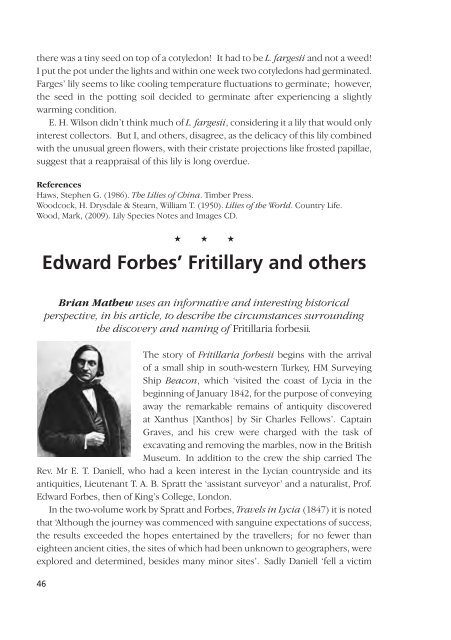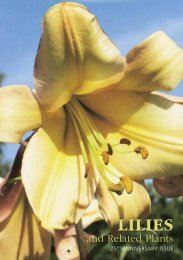Lilies and Related Plants - RHS Lily Group
Lilies and Related Plants - RHS Lily Group
Lilies and Related Plants - RHS Lily Group
You also want an ePaper? Increase the reach of your titles
YUMPU automatically turns print PDFs into web optimized ePapers that Google loves.
there was a tiny seed on top of a cotyledon! It had to be L . fargesii <strong>and</strong> not a weed!<br />
I put the pot under the lights <strong>and</strong> within one week two cotyledons had germinated.<br />
Farges’ lily seems to like cooling temperature fluctuations to germinate; however,<br />
the seed in the potting soil decided to germinate after experiencing a slightly<br />
warming condition.<br />
E. H. Wilson didn’t think much of L . fargesii, considering it a lily that would only<br />
interest collectors. But I, <strong>and</strong> others, disagree, as the delicacy of this lily combined<br />
with the unusual green flowers, with their cristate projections like frosted papillae,<br />
suggest that a reappraisal of this lily is long overdue.<br />
References<br />
Haws, Stephen G. (1986). The <strong>Lilies</strong> of China. Timber Press.<br />
Woodcock, H. Drysdale & Stearn, William T. (1950). <strong>Lilies</strong> of the World. Country Life.<br />
Wood, Mark, (2009). <strong>Lily</strong> Species Notes <strong>and</strong> Images CD.<br />
46<br />
★ ★ ★<br />
Edward Forbes’ Fritillary <strong>and</strong> others<br />
Brian Mathew uses an informative <strong>and</strong> interesting historical<br />
perspective, in his article, to describe the circumstances surrounding<br />
the discovery <strong>and</strong> naming of Fritillaria forbesii .<br />
The story of Fritillaria forbesii begins with the arrival<br />
of a small ship in south-western Turkey, HM Surveying<br />
Ship Beacon, which ‘visited the coast of Lycia in the<br />
beginning of January 1842, for the purpose of conveying<br />
away the remarkable remains of antiquity discovered<br />
at Xanthus [Xanthos] by Sir Charles Fellows’. Captain<br />
Graves, <strong>and</strong> his crew were charged with the task of<br />
excavating <strong>and</strong> removing the marbles, now in the British<br />
Museum. In addition to the crew the ship carried The<br />
Rev. Mr E. T. Daniell, who had a keen interest in the Lycian countryside <strong>and</strong> its<br />
antiquities, Lieutenant T. A. B. Spratt the ‘assistant surveyor’ <strong>and</strong> a naturalist, Prof.<br />
Edward Forbes, then of King’s College, London.<br />
In the two-volume work by Spratt <strong>and</strong> Forbes, Travels in Lycia (1847) it is noted<br />
that ‘Although the journey was commenced with sanguine expectations of success,<br />
the results exceeded the hopes entertained by the travellers; for no fewer than<br />
eighteen ancient cities, the sites of which had been unknown to geographers, were<br />
explored <strong>and</strong> determined, besides many minor sites’. Sadly Daniell ‘fell a victim




